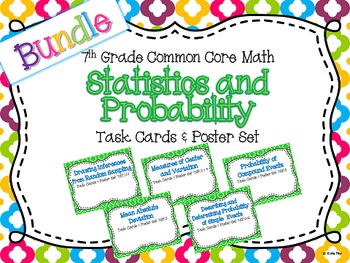7th Grade Statistics and Probability Unit Resource Bundle
- Zip
Products in this Bundle (5)
Description
Provide your class with anchor charts, standards posters and task cards for every 7th Grade Statistics and Probability standard. The task card activities are great for individual, small group, or whole group instruction and review. Questions about drawing inferences from random samples, measures of center, measures of variation, mean absolute deviation, describing probability of simple events, determining probability of simple events, probability of compound events, and more. The questions range from simple to complex and are easy to differentiate for your students. Answer record sheets and answer keys (traditional and QR codes) are also provided.
Statistics and Probability Bundle
This bundle includes the following individual products that can be found in my store:
**Drawing Inferences from Random Sampling Task Card and Poster Set
**Measures of Center and Variation Task Card and Poster Set
**Mean Absolute Deviation Task Card and Poster Set
**Describing and Determining Probability of Simple Events Task Card and Poster Set
**Probability of Compound Events Task Card and Poster Set
Each task card and poster set includes the related common core standards posters and concept posters that explain and provide examples for each related concept.
Buy the BUNDLE and Save!!


